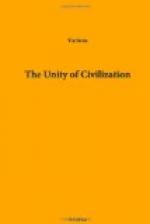For a time, and in some measure, they were actually accomplished. Let us look at each estate in turn, and measure the accomplishment—speaking first of the knightly world, and the Church’s control of war and peace; then of the world of the commons, and the Church’s control of trade and commerce; and last of the clerical world and the Church’s control of learning and education.
The control of war and peace was a steady aim of the Church from the beginning of the eleventh century. The evil of feudalism was its propensity to private war. To cure that evil the Church invented the Truce of God. The Truce was a diocesan matter. The ‘form’ of Truce was enacted in a diocesan assembly, and the people of the diocese formed a communitas pacis for its enforcement. There was no attempt to put an absolute stop to private war; the Truce was only directed to a limitation of the times and seasons in which feuds could be waged, and a definition of the persons who were to be exempted from their menace. But from seeking to limit the fighting instinct of a feudal society, the Church soon rose to the idea of enlisting that instinct under her own banner and directing it to her own ends. So arose chivalry, which, like most of the institutions of the Middle Ages, was the invention of the Church. Chivalry was the consecration of the fighting instinct to the defence of the widow, the fatherless, and the oppressed; and by the beginning of the eleventh century liturgies already contain the form of religious service by which neophytes were initiated into knighthood. This early and religious form of chivalry (there was a later and lay form, invented by troubadour and trouvere, which was chiefly concerned with the rules for the loves of knights and ladies) culminated in the Crusades. In the Crusades we touch perhaps the most typical expression of the mediaeval spirit. Here we may see the clergy moulding into conformity with Christian principle the apparently unpromising and intractable stuff of feudal pugnacity: here we may see the papacy asserting its primacy of a united Europe by gathering Christian men together for the common purpose of carrying the flag of their faith to the grave of their Redeemer. Here the permeating influence of Christian revelation may be seen attempting to permeate even foreign policy (for what are the Crusades but the foreign policy of a Christian commonwealth controlled and directed by the papacy?); and here again even the instinct for colonial expansion, so often the root of desperate wars, was brought into line with the unity of all nations in Christ, and made to serve the cause of Him ’in whom alone is to be found the true nature of the One’.




